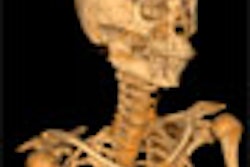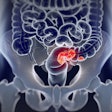Cardiac CT can be performed successfully with lower contrast volumes and flow rates when contrast agents are more concentrated, according to a new study. Researchers in Germany reported that 16-slice cardiac CT angiography (CTA) produced equivalent opacification compared to the use of a less-concentrated agent and higher volumes.
"The ability to obtain excellent contrast enhancement on MDCT coronary angiography (without streak artifacts arising from dense contrast material in the right atrium), combined with the high contrast resolution achievable, permits not only the improved identification of small coronary vessels, but also if the vessel lumen is opacified adequately, the identification of low-density coronary atherosclerotic lesions," wrote Dr. Carsten Rist; Dr. Konstantin Nikolaou; Miles Kirchin, Ph.D.; and colleagues from Ludwig-Maximilians University in Munich, Germany (Investigative Radiology, May 2006, Vol. 41:5, pp. 460-467).
The goal is to achieve overall vessel lumen opacification of 250-300 Hounsfield units (HU), and ideally differentiate atherosclerotic lesions (approximately 40 HU) from intermediate fibrous plaques (approximately 90 HU), and calcified plaques (> 350 HU), the authors explained.
The injection of smaller volumes at slower flow rates may be safer and more tolerable to patients. Aiming to achieve equivalent results with smaller contrast volumes, the researchers compared two commercially available contrast agents: a standard 300-mg iodine/mL injection of iodinated contrast medium (iomeprol, Iomeron 300, Bracco, Milan, Italy) at a standard flow rate with a more highly concentrated version (Iomeron 400, Bracco) at an equivalent injection dose.
In the study, 60 patients with known or suspected coronary artery disease (> 50% pretest likelihood of coronary artery disease) were randomized into two groups. Group 1 (17 men, 13 women; mean age 58.1) received 83 mL of the 300-mg formula at 3.3 mL/sec, while group 2 patients (15 men, 15 women; mean age 62.2) received 63 mL of the 400-mg formula at 2.5 mL/sec. The test bolus volumes were 20 mL and 15 mL, respectively.
Images were acquired on a 16-detector CT scanner (Somatom Sensation 16, Siemens Medical Solutions, Erlangen, Germany) at 120 kVp, 750 effective mAs with ECG pulsing to reduce radiation exposure, 16 x 0.75-mm collimation, and 0.375-sec rotation time.
"Image reconstruction was performed with retrospective gating at individual diastolic time points (approximately -350 milliseconds before the R-wave)" using 1-mm slice thicknesses and 1.5-mm increments, according to the authors.
The test bolus and main bolus injections (separated by a saline flush) were administered using a power injector and an 18-gauge needle, and "the individual delay time (time to peak of test bolus plus 5 seconds; end of main bolus injection/initiation of scan) by means of a bolus tracking technique," the team wrote.
"No noteworthy differences between groups were noted for density measurements in the cardiac chambers or for the ratio of right-to-left ventricle density," the researchers wrote. Mean contrast densities of the coronary arteries were 259.1 ± 46.7 HU for group 1 and 251.6 ± 51.0 HU for group 2.
"Although the mean deviation tended to be higher for the iomeprol 400 administration regimen (Cohen's effect size = -27; 95% confidence interval = -80 to 0.26), the lower limit of the confidence interval did not exceed the benchmark of a large difference (-0.080), indicating that there was no relevant difference between the injection protocols ... in terms of deviation of postcontrast density from the target value of 300 HU," the team wrote.
The contrast between noncalcified areas and vessel lumen was between -178 and -192 HU depending on the reader and study group, while the contrast between calcified areas and vessel lumen was between 326 and 382 HU.
"These findings indicate that differentiation of calcified and noncalcified plaques from vessel lumen is independent of the iodine concentration of the contrast medium if the injection protocol is modified appropriately to deliver an equivalent total iodine dose," the group wrote.
A positive correlation was found for both groups between the area under the curve of the test bolus and the mean density of the main bolus; however, a positive correlation between peak density of the test bolus and mean density of the main bolus was found only in group 1, the authors noted.
Mean heart rates were 57.3 ± 3.7 beats per minute (bpm) for group 1 and 57.4 ± 4.3 bpm for group 2, and there were no clinically meaningful deviations for any patient.
Among potential limitations, body weight differences among patients, while not significant, were not accounted for. In addition, any differences in diagnostic accuracy between two very similar contrast media would not necessarily have been observed, the group noted.
"One possible advantage of administering a more highly concentrated contrast medium with reduced total volume and at a lower injection rate may be improved patient tolerability," the authors concluded. "The findings presented demonstrate that optimal coronary vessel opacification is achievable with the two dosing regiments in patients with low to moderate pretest likelihood of (coronary artery disease)."
By Eric Barnes
AuntMinnie.com staff writer
May 22, 2006
Related Reading
CTA narrows down plaque patterns in coronary arteries, May 8, 2006
CTA proves faster and cheaper for assessing chest pain in ER, April 11, 2006
Cardiac imaging dazzles, but radiologists can't compete alone, April 10, 2006
ACC studies examine CTA radiation dose, March 17, 2006
CTA finds heart disease when calcium score is unreliable, April 5, 2006
Copyright © 2006 AuntMinnie.com




















